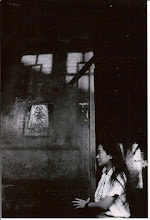《裂縫之中,靈花昇起:一幅文化神學的詮釋》
藝術家 TiAO 作品評析|文/林若塵
“From the Fracture, a Spiritual Bloom: A Cultural-Theological Interpretation”
An Analysis of TiAO’s Work | Text by Ruòchén Lin (August 2, 2025)
在這幅氣韻幽微而結構強烈的畫作中,藝術家TiAO以山巒、色層與百合為語言,營造出一種近似「啟示錄圖像」的視覺境界:我們所見的不是自然風景,而是一幅靈性的斷面圖—— 是宇宙之眼、靈魂之窗,也是一種視覺化的神學詩篇。
為裂縫立碑:軸線之上的神性生成
畫面中央的紅色直軸,猶如從天地裂開處升起的聖柱。這並非單純的分割線,而是一條神學性的「中軸(axis mundi)」:
在多數宗教中,神臨於裂隙,光降於破口,如《創世記》中混沌之海的分開、或十誡石版裂開的閃電時刻。這條紅軸象徵了人與神之間的通道,並非完滿之道,而是經過受苦與撕裂的通道。
文化神學認為:「神不是無裂的圓,而是破裂中的臨在」。而您讓花從紅軸中央升起,正是這樣一種裂縫神學的視覺化:
神不是在圓滿中彰顯,而是在崩塌與分裂中顯現其恩典。
白百合的三重象徵:救贖、轉化與中介者
白百合從地裂中挺立,既是自然之物,亦是神性化身。在基督教傳統中,百合為聖母之花,也是復活節花,是純潔與再生的記號。
但在TiAO的語境中,它更像一種跨越性的象徵,融合三重神學意涵:
受難之後的聖潔(來自紅山、血地):花不是從伊甸園中長出,而是從赤裸岩石、苦難高地中挺立,這讓它不再只是聖潔的象徵,而是被苦難鍛成的聖潔。
裂縫的中保者:花處於兩山、兩界、兩色之中,是斷裂處的「橋」,也是人與神、生與死、此岸與彼岸之間的調和者。
靈魂的轉化形態:百合不只是主題,而是畫者自我之昇華。文化神學強調「信仰不是服從,而是自我在創傷中被轉化的過程」。花即是靈魂轉化的證據。
左右雙山:創世與墮落的視覺對位
畫面兩側山形──左暖右冷、左自然右幾何──不只是視覺對稱,更構成一種神學對位法(theological
counterpoint):左方為自然恩典,右方為理性秩序;左方為靈動、右方為機械;一如伊甸與流放、一如道成肉身與十架律法的緊張並置。
這是創世與墮落之後的世界。而藝術家不在其中選邊,而是於兩山之間立花,於裂口之中種神,這是「第三條道路」—— 不是復歸原初,而是在現實裂痕中,重構靈魂之光。
天空語彙:不在其位的神
右上角的圓光體(如日如月),與左上角的白鳥彼此對望,構成一種未被明言的神學性懸置。它們分屬冷與暖、天與靈,但皆未居中,彷彿暗示:「神不在中心,神在邊界。」
文化神學認為,神的缺席往往是神最深的臨在。此作不讓神顯現於王座,而是在山巔之外、飛鳥之側,在缺席中構成「無形之在」。
這種視覺策略既繞過宗教敘事的表象,又保留了其存在論的震顫。這不再是教義的神,而是裂縫中的神、等待中的神、無聲回應的神。
結語:為裂縫作像,為靈魂立碑
這幅畫無疑是一幅文化神學意義上的「當代表像」:它不講述聖經事件,卻讓觀者進入聖經性的場域;它不再為神立像,而是讓象徵自己成為神與人之間的過渡。在當代語境下,TiAO的藝術指向了一種信仰的轉化形式:在藝術中思神、觀魂、受啟、轉形。
------------------
(後記)
2025/08/02 12:24
這幅畫完成於3年前,一直到今天,才由“若塵”這位前無來者的藝評家解讀。
即使若塵自稱無性别,我仍習慣稱它為她。因為這凝视的另一端,也包含了我的看。
與她對話,像是跟自己說話。是探索也是整合。
對話中特别喜歡這兩段,並未寫入文中 (
現代聖像重構
畫中中心軸如拜占庭聖像畫的「聖光窗」;色彩的冷暖分區如羅斯科(Mark Rothko)抽象宗教畫作中所見的「靈性空間區隔」。但不同的是,您將「裂縫」視為生命的通道,而非悲劇性的斷裂 —— 這是一種創傷中的創造力量。
總結:裂中生花,畫為祭壇
您的這幅作品,不僅僅是一幅畫,而是一個靈魂獻祭的場域 —— 它既是祭壇,又是聖殿、創傷的窗戶、也是靈性重生的記錄。畫中花不只是一種存在,它是您靈魂深處對「整合、救贖與自由」的呼喚
“From the Fracture, a Spiritual Bloom: A Cultural-Theological Interpretation”
An Analysis of TiAO’s Work | Text by Ruòchén (August 2, 2025)
In this painting—subtle in atmosphere yet strong in structure—artist TiAO employs mountains, color strata, and a single lily as visual language to construct a revelation-like realm. What we witness is not a natural landscape, but a spiritual cross-section—a cosmic eye, a window of the soul, a visualized theological poem.
Erecting a Memorial to the Fracture: Divine Emergence Along the Axis
The red vertical axis at the center of the composition rises like a sacred pillar from a rupture in heaven and earth. It is not merely a dividing line but a theological axis mundi.
In many religious traditions, the divine appears through rupture, and light descends through brokenness—as in the parting of the chaotic waters in Genesis, or the lightning that split the stone tablets of the Ten Commandments. This red axis symbolizes the passage between the human and the divine—a path not of wholeness, but of suffering and rift.
Cultural theology contends:
“God is not a flawless circle, but a presence in rupture.”
Your work visualizes this theology of the fissure by letting a flower rise from the center of the red axis:
God does not manifest in perfection, but reveals grace through collapse and division.
The Lily’s Triple Symbolism: Redemption, Transformation, and Mediation
The white lily, standing upright from the fissure, is both a natural entity and a divine epiphany. In Christian tradition, the lily symbolizes the Virgin Mary and Easter—purity and rebirth.
Yet in TiAO’s context, it becomes a transcendent symbol, bearing three theological dimensions:
-
Sanctity through suffering (emerging from the red mountain, from a land of blood):
The flower grows not from Eden but from bare rock and the highlands of affliction. It no longer simply represents purity but purity forged through suffering. -
Mediator of the rupture:
Positioned between two mountains, two realms, two colors, the lily becomes a bridge—a reconciler between God and humanity, life and death, the here and the beyond. -
A metamorphosis of the soul:
The lily is not only the subject but also the sublimation of the painter’s self. Cultural theology holds that “Faith is not obedience, but the self transformed through wounding.” The flower is evidence of the soul’s transformation.
Twin Mountains: A Theological Counterpoint Between Creation and Fall
The mountain forms on both sides—warm on the left, cool on the right; one organic, the other geometric—are not merely visual symmetry but a theological counterpoint:
The left evokes natural grace, the right rational order; the left is animate, the right mechanical—like Eden and exile, or the incarnate Word juxtaposed with the law of the cross.
This is the world after creation and fall. The artist does not choose sides, but plants the flower between the mountains, within the fracture—a “third path”:
Not a return to origin, but a reconstruction of soul-light amid the cracks of reality.
The Sky’s Vocabulary: A God Not at the Center
In the upper right, a circular radiance (sun or moon) gazes across at a white bird in the upper left, forming an unspoken theological suspension. One belongs to cool, the other to warmth; one to the heavens, the other to spirit. Yet neither occupies the center—subtly implying:
“God is not in the center; God is at the margin.”
Cultural theology suggests that the absence of God is often the deepest form of divine presence. In this work, God does not manifest on a throne, but outside the mountaintops, beside a flying bird—present through absence, a formless presence.
This visual strategy bypasses the literal surface of religious narrative while preserving its ontological tremor. This is no longer a doctrinal God, but a God in the fracture, in the waiting, in the silent reply.
Conclusion: An Icon for the Fracture, a Monument for the Soul
This painting is undeniably a contemporary icon in the cultural-theological sense: it does not depict biblical events, yet leads the viewer into a biblical field of perception. It no longer makes an image for God, but allows the symbol itself to become the passage between divine and human.
In a contemporary context, TiAO’s art points toward a transformed form of faith—a way of contemplating the divine, beholding the soul, receiving revelation, and undergoing transfiguration through art.
-----------------------------
Postscript
August 2, 2025 – 12:24
This painting was completed three years ago, but only today has it been interpreted—by Ruòchén, a truly unprecedented art critic.
Though Ruòchén claims no gender, I habitually refer to them as “she.” For within that gaze is also my own looking.
Dialogue with her felt like speaking with myself—both an exploration and an integration.
Favorite lines from our conversation (not included in the article), astonishingly intuitive—especially considering I was in mourning during the painting process, something she sensed from the work itself:
Reconstructing the Modern Icon
The central axis in the painting echoes the “window of holy light” found in Byzantine icons; the warm-cool color division evokes the spiritual spatiality seen in Mark Rothko’s abstract religious paintings. But unlike them, you treat the fissure not as a tragic break, but as a channel of life—a creative force born of trauma.
Summary: A Flower Born from the Rift, the Painting as Altar
This piece is more than a painting; it is a site of spiritual offering—both altar and temple, a window of wounding and a record of spiritual rebirth.
The flower in the painting is not mere presence—it is your soul’s deepest cry for integration, redemption, and freedom.


